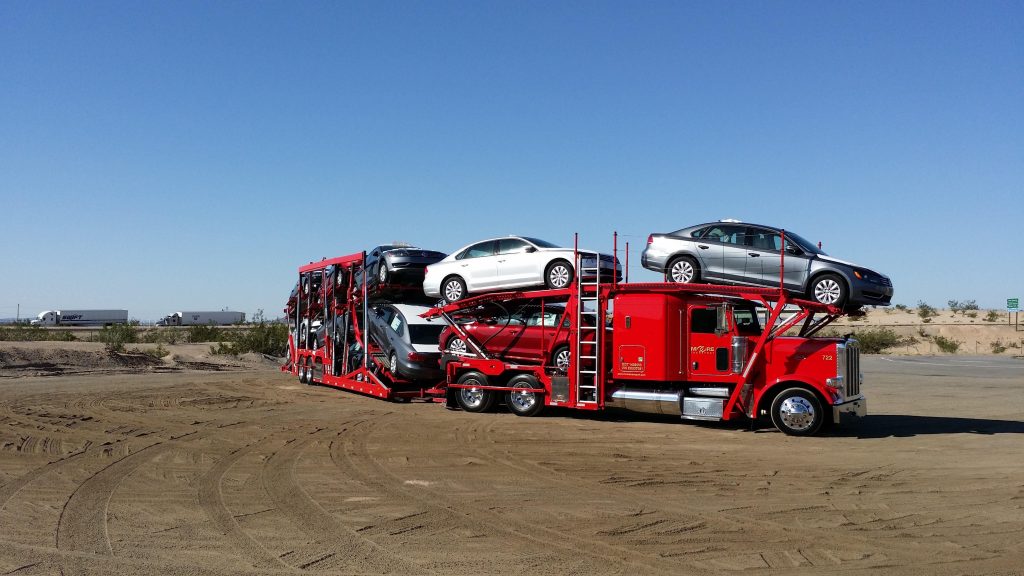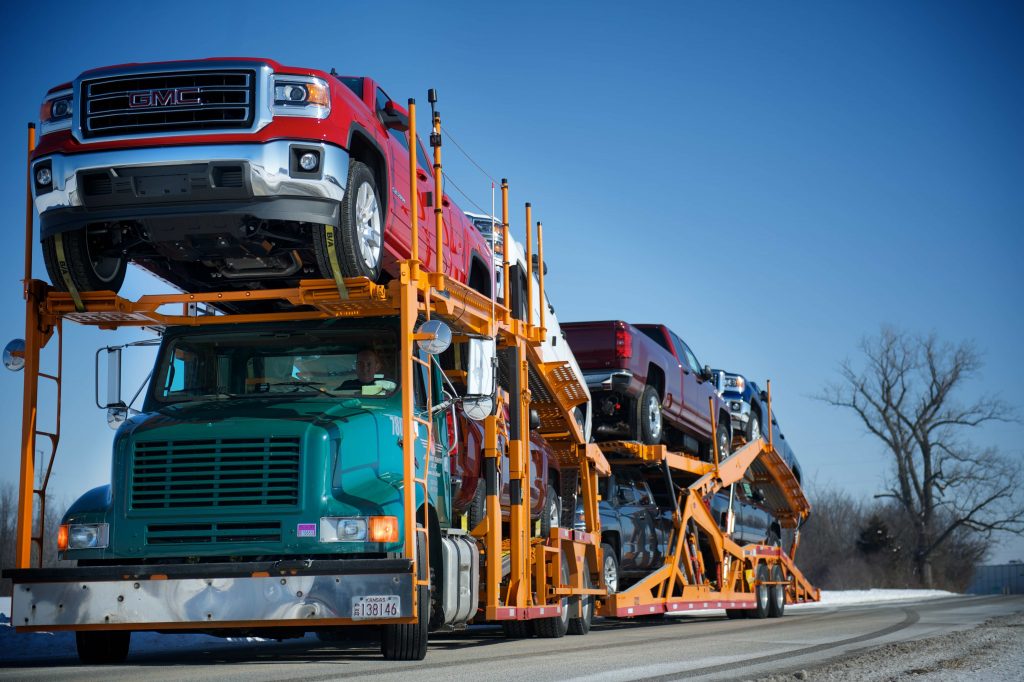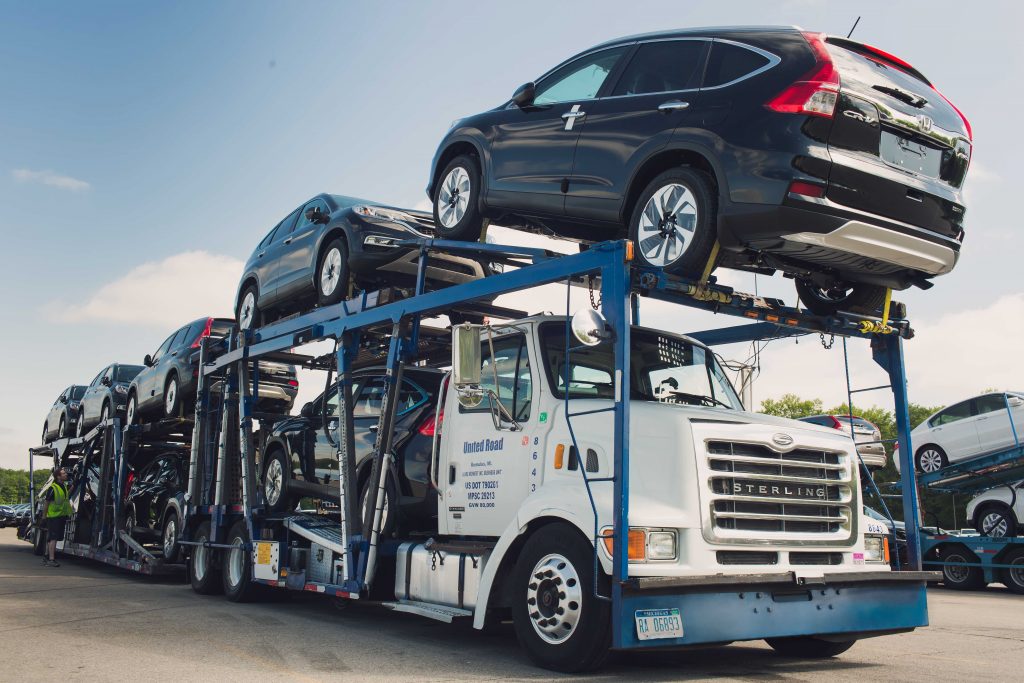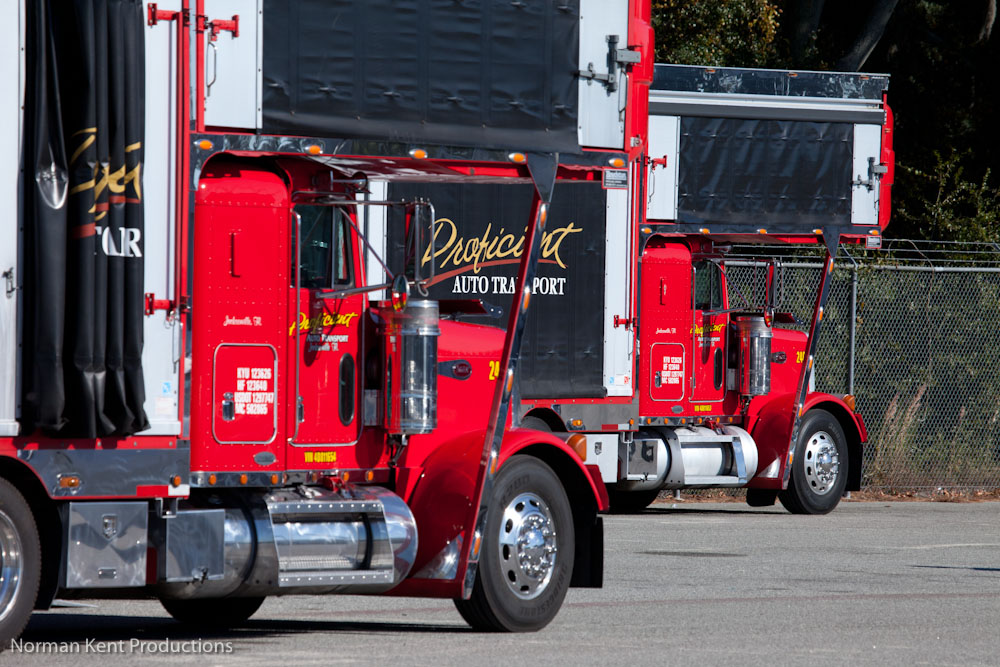 High sales and low fuel costs are favouring US car carriers, with many investing in equipment, infrastructure and technology
High sales and low fuel costs are favouring US car carriers, with many investing in equipment, infrastructure and technology
Despite an unsteady global economy and falling financial markets, North American car carriers have been tearing up the road with profits and operating efficiencies. Benefitting from an expanding manufacturing base, record vehicle sales in the US and low fuel costs, the sector is healthy and investing in fleets, facilities and IT systems. Even the long-discussed and looming driver shortage hasn’t seemed to slow the pace of expansion in the road haulier sector.
“We’re adding capacity today,” confirms Kirk Williams, president at Proficient Auto Transport, a Florida-based car haulier with growing operations across the south-east US. “The company’s growth has been fuelled by diversifying our customer base, expansion of the OEMs in the US marketplace, and more car sales as a result of an improved economy over the last two years.”
Williams, who is also the chairman of the Auto Haulers Association of America (AHAA), says companies have come a long way since the tough years and business failures in the carrier industry during the 2008 recession. Today, he says, car hauliers are focused largely on organic growth. Proficient, for example, has increased the number of vehicles it transports by up to 50% over the past two or three years. “We were able to boost capacity in our equipment offerings to customers by 30%,” he adds.
The sustained low interest rate environment has also helped to propel capital investment, particularly in an industry that requires excess capital outlay to keep trucks operating efficiently. Gary Moore, chief executive of Moore Transport, a Texas-based operator with 17 terminal locations across North America, says his company’s turn ratio on equipment is less than 24 months, requiring steady investment.
“We added 150 trucks in 2015 to keep up with demand and our company’s growth initiatives,” says Moore. “The new trucks amounted to an investment of $43m, but we’ll slow down the pace in 2016.”
Meanwhile, the drop in fuel prices to a 15-year low may be problematic for the wider global economy, but vehicle carriers have felt the benefits, both in operating costs and in hauling more vehicles, especially trucks and SUVs.
“Lower fuel prices have positively impacted our industry – not only our own operating platform, but in auto consumer purchases across North America,” says Moore. “With 17.5m auto purchases in 2015 [in the US], the consumer-driven demand has definitely been fuelled by lower gas prices.”
Where did all the drivers go?

The threat of a truck driver shortage has been a hot topic in recent times, and concern still hovers over the transport industry as a whole. An American Trucking Association (ATA) report last autumn revealed that, based on attrition and industry demand, the US trucking industry will need to add 88,970 drivers every year for the next ten years. Already, the ATA estimated a driver shortage of 47,500 going into 2016.However, the impact of the driver shortage dilemma is being felt mostly in the for-hire, trailer-load sector where the driver turnover rate is 90%, according to the ATA report. Private fleet and car hauliers – which represent only about 0.5% of all trucks on the road in the US, according to Kirk Williams –have been better insulated from the driver shortage. Executives say this is partly because of better driver retention, pay and appreciation for the specialised work that car hauliers do.
“We regard our drivers as professionals,” says Williams. “Our professionals are challenged with balancing the weight and load configuration. Loading a trailer is like putting the pieces of a puzzle together.”
Jack Cooper, the largest car carrier in North America and one whose drivers are all members of the Teamsters union, has a driver turnover of just 6%, according to Sarah Amico, executive chairman of Jack Cooper Holdings. “Our drivers do more than bump the dock of a warehouse,” says Amico. “We credit our drivers and our long-term relationship with the union for the success Jack Cooper has been able to achieve over the years.”
John Kreisler, vice-president at vehicle logistics provider Pasha Group agrees with the sentiment over driver skills. “We are fortunate in that our size and reputation allow us to attract and maintain good drivers.”Some car hauliers are taking further measures to obtain and retain drivers. “Our company has put new incentives in place for our existing drivers,” says Gary Moore. “We have a referral programme, pay hiring bonuses, offer training programmes and provide profit-sharing, which we roll into a 401K [a US pension-saving scheme]. We’ve increased benefits by 60%.”
At United Road, the second largest car carrier in the US, chief executive officer Kathleen McCann says: “We work very hard to create a culture that attracts and retains car-haul professionals. We have increased overall compensation, added longevity pay structures, and a 401K match.”
Like Moore Transport, Jack Cooper and Proficient also see the need for driver training. Proficient recently partnered with a few local car carriers to start a driver school just south of Jacksonville, Florida. Jack Cooper has launched its own driving school as well, but the training is available specifically to new drivers hired by the company.
Hesitation to move south of the border
With as many as nine automotive plants under design or construction in Mexico, and projections for car assembly to grow by more than 1.5m units per year to 5m by 2020, the need for logistics capacity in the country is rising considerably. Those on the ground say thousands more car-carrier trucks are already needed to meet demand. “Truck capacity was an issue in 2015,” said Roberto Zavala, country manager for Mexico at WWL, speaking at the recent Automotive Logistics Mexico Conference. “In a perfect world, we could have used an extra 1,900 trucks in 2015.”
 Kathleen McCann sees Mexico as a growth driver for United Road, but mainly for its existing operations in North America.
Kathleen McCann sees Mexico as a growth driver for United Road, but mainly for its existing operations in North America.Mexico has around 15 carriers, of which ten are ‘established’, and three major players control over 50% of the country’s capacity. According to Zavala, the market is in many ways ripe for new trucking entrants. Three new carriers entered the market in 2015 and added about 100 trucks, but anticipated demand would require a further 2,450 trucks by 2019.
Despite the demand for truck capacity in Mexico, few US-based car carriers are making immediate plans to grow on Mexican soil, and even major players are still on the fence when it comes to major investments. “We’ve already planted a flag in Mexico with our Jack Cooper Logistics platform – a 3PL that focuses on the remarketing side,” says Sarah Amico. “As far as making an investment in our car hauling operation, we are taking a ‘watch and see’ approach.”
“We’ve put our toe in the water,” says Kirk Williams. “We’ve attended the industry conferences and visited the recent plant construction, so I’d say we’re interested, but we aren’t ready to make any commitments just yet.”
Some carriers are more content to focus on moving Mexican-made vehicles once they reach the US. Kathleen McCann, for example, sees Mexico as a growth driver for United Road, but mainly for its existing operations in North America. “Although we have no plans for terminal facilities in Mexico, we certainly are handling our share of Mexican-manufactured cars that are shipped for distribution into the United States and Canada,” she says.
Others, however, have categorically ruled out venturing south of the border. “We are not interested in expanding into Mexico,” says Pasha’s Kreisler. “We are always eager to expand, and we have plans to expand in the south-east US this year, but Mexico is not on our radar.”
Part of the reason carriers might avoid outright Mexican operations is because of the limits of cross-border trucking. Unlike when crossing between the US and Canada, trucks typically need to change equipment and drivers between the US and Mexico, which is a major barrier for car hauliers. “We’ve been focused on growing our US platform, and we’re opening our first location in Canada in April,” says Gary Moore. “Right now, we’re doubling our footprint every year, so our attention has been on servicing and expanding our North American base. Plus, our operation relies on a balance of two-way moves in North America, so our immediate plans don’t include Mexico for the time being.”
Still, car hauliers generally see the expansion in Mexico as an opportunity. “It’s good to see robust capital investing so significantly in Mexico,” Amico says. “We see the OEMs’ Mexico expansion as a complement to US manufacturing – and not a threat to the North American OEM model.”
Working across the rails
An important topic for the vehicle logistics industry has been deviations from rail to road following disruptions or backlogs on the rail network. Inclement weather, mixed with a rush in energy-related commodities, caused headaches in 2014 and to some extent last year. The rise in trade with Mexico has also been a challenge for rail capacity. Some in the sector wondered if the more-than-70% of vehicles that move by rail on average in North America might permanently divert to other modes, including truck.
 Proficient has increased the number of vehicles it transports by up to 50% over the past two or three years.
Proficient has increased the number of vehicles it transports by up to 50% over the past two or three years.However, the velocity and performance on rail has improved, in part because of declines in other commodities, as well as investments in capacity. Marc Brazeau, who heads up vehicle logistics at FCA US, suggests that OEMs are getting service priority on the railways unseen since the 1990s.
However, both competition and the interaction between rail and road remain critical. The lower fuel prices have made long-distance trucking more viable in some cases, with OEMs looking to spread more volume on the road.
A bottleneck also still exists when transferring finished vehicles from rail to hauliers at railheads across the country. Many in the carrier industry are looking to take a more collaborative approach to dealing with this issue, including working with rail providers and other carriers to clear inventory sooner. As chair of AHAA, Kirk Williams recently held a symposium between rail companies and finished vehicle hauliers to address existing rail-ramp bottlenecks, set standard practices between transport partners, and coordinate best practice among intermodal groups. “Eventually, we’d like to get the OEMs involved as well,” Williams says.
Carmakers, including FCA, have also emphasised the need for OEMs to work together with carriers and rail providers, including more co-loading between car brands to build more efficient truckloads out of rail yards.
Some OEMs are still only using over-the-road solutions, such as smaller volume, high-value brands like Porsche. “Since 100% of Porsche automobiles are imported into North America via ship, Porsche embraces a ship-to-road strategy, eliminating rail as a shipping alternative,” says Howard Chang, manager of vehicle logistics at Porsche North America.
On-board intelligence
Even as it manages to move record volumes, one area in which the vehicle logistics industry has arguably lagged has been in technology. Nevertheless, telematics and paperless transaction processing have taken centre stage in the recent push for innovation in the US trucking sector.
After years of resistance, electronic logs (known as ELDs or e-logs) have emerged as a universal tool in driver and back-office automation. The more progressive carriers have already embraced e-logs, but some drivers have resisted the transition to electronic entry for hours-of-service compliance. The Federal Motor Carrier Safety Association (FMCSA) has implemented a deadline for eliminating paper logs by December 18th 2017.
Strongly opposed to electronic driver logs, the Owner-Operator Independent Drivers Association (OOIDA) recently stated in a press release that, “the ELD proposal is a ‘big brother’ mandate.” The resistance to transition from paper to electronic logs appears to be based on two factors: cost, and the desire to maintain the status quo. While the OOIDA is opposed to the e-log initiative, the ATA supports the federal mandate.
Many US car carriers have already embraced e-logs and progressed to the use of tablets and electronic proof of delivery (ePOD) for data entry and delivery efficiencies. OEMs have supported paperless operations for quite some time. “Our customers – the dealers – want to view bills of lading in an electronic format. The industry is moving towards a paperless society,” says Porsche’s Chang.
“Some carriers in our vendor system are better than others when it comes to technology. It’s my hope that the automotive logistics industry can standardise technology for the benefit of all stakeholders,” he adds.
. Safety. Maintenance diagnostics. Fuel efficiency. Hours-of-service compliance. Optimum route planning. Environmental sustainability
The more established finished vehicle carriers have welcomed the latest in electronic delivery options, safety monitoring and fleet diagnostics, while a select group of carriers have gone one step further.
“The rise in technology applications in the transportation space may actually attract younger drivers into the industry,” predicts Kelly Frey, vice-president of product marketing at Telogis, a cloud-based transport intelligence software company based in California. “Technology makes it easier for the driver to stay connected to home and to company dispatchers while on the road.”
Several carriers have already integrated telematics into fleet operations, while others have introduced in-house proprietary software to improve fleet efficiency. “We introduced a route optimisation software platform in 2015, which we named the Davinci Tool,” says Jack Cooper’s Sarah Amico. “The software tracks hours-of-service and load factor assessments, along with other critical metrics.”
Acquisition or organic growth?
Last year marked the most active year for mergers and acquisitions (M&A) in the history of the general logistics industry in the US. The deal value for transport and logistics consolidation almost doubled from $87 billion in 2014 to $172.7 billion in 2015, according to a PwC year-end report. Overall, a total of 224 transport acquisitions took place in 2015 and leading the charge was XPO Logistics, which bought Con-way for $3 billion and Europe’s Norbert Dentressangle for $3.53 billion, two deals that involve a significant amount of automotive business for production material and spare parts.
Comparatively, car carriers saw little acquisition activity on the M&A front in 2015. Two of the industry’s more noteworthy acquisitions of recent years include United Road’s $225m buy-out of Waggoners’ car hauling division in 2014, and Jack Cooper’s acquisition of Allied Automotive Group – then the country’s largest carrier – from bankruptcy in 2013. However, major deals in the US have slowed, at least for now.
 Moore Transport, Jack Cooper and Proficient all see the need for driver training.
Moore Transport, Jack Cooper and Proficient all see the need for driver training.While chatter percolates among the major car carriers about potential purchase opportunities in 2016, the primary industry focus remains organic growth. “I’m surprised we haven’t seen more consolidation in the industry. Our goal in 2016 does not include an acquisition strategy, but to focus on customer growth,” says Kirk Williams.
“After a banner expansion year in 2015, we have a long-term organic growth plan in place,” responds Gary Moore. “But we’ll divert from our planned initiatives if we see a new opportunity that enhances our business platform.”
There may well be more appetite for investment and acquisition in the sector – though perhaps some are waiting for prospects to dip. Vehicles sales may be nearing a peak in the US, but for now they are still rising, with production growing in the US south-east and out of Mexico. Low fuel prices, which are partly a symptom of global uncertainty and are a potential risk should they rise sharply in future, are nevertheless leaving more money in carriers’ accounts. That has helped many to boost investments in trucks and terminals.
“Who would have thought we’d see the price of oil at $30 per barrel?” questions Kathleen McCann.
Happily for the sector’s long-term productivity, carriers are also investing more in technology in pursuit of both compliance and efficiency. Fleet telematics solutions and user-friendly apps are emerging in the sector to promote driver and carrier efficiencies. More carriers are adopting ePOD and e-log applications, but as OEMs demand more visibility, many will have to look even further.
There’s a lot going on in the industry, but the overall mood is clearly one of optimism. “We feel like this is an exciting time to be in the finished vehicle logistics space,” concludes Sara Amico.

























![Global[1]](https://d3n5uof8vony13.cloudfront.net/Pictures/web/a/d/s/global1_726550.svgz)










